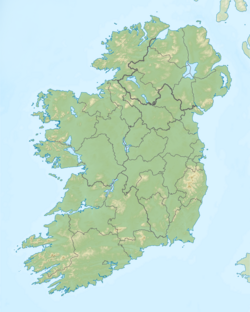
Back نيوغرانغ Arabic Newgrange AST Шы-ан Вру BE-X-OLD Нюгрейндж Bulgarian Arheološko nalazište Boyne BS Newgrange Catalan Newgrange CEB Newgrange Czech Newgrange Welsh Newgrange Danish
Sí an Bhrú | |
 | |
 | |
| Location | County Meath, Ireland |
|---|---|
| Type | passage grave |
| Width | 76 metres (249 ft) |
| Area | 1.1 acre (0.5 hectare) |
| Height | up to 12 metres (39 ft) |
| History | |
| Founded | c. 3200 BC |
| Periods | Neolithic |
| Site notes | |
| Excavation dates | 1962–1975 |
| Archaeologists | Michael J. O'Kelly |
| Ownership | Office of Public Works |
| Public access | yes (guided tour only) |
| Official name | Brú na Bóinne |
| Type | Cultural |
| Criteria | i, iii, iv |
| Designated | 1993 (17th session) |
| Reference no. | 659 (official listing) |
| Region | Europe |
Newgrange (Irish: Sí an Bhrú[1]) is a prehistoric monument in County Meath in Ireland, located on a rise overlooking the River Boyne, eight kilometres (five miles) west of the town of Drogheda.[2] It is an exceptionally grand passage tomb built during the Neolithic Period, around 3200 BC, making it older than Stonehenge and the Egyptian pyramids. Newgrange is the main monument in the Brú na Bóinne complex, a World Heritage Site that also includes the passage tombs of Knowth and Dowth, as well as other henges, burial mounds and standing stones.[3]
Newgrange consists of a large circular mound with an inner stone passageway and cruciform chamber. Burnt and unburnt human bones, and possible grave goods or votive offerings, were found in this chamber. The monument has a striking façade made mostly of white quartz cobblestones, and it is ringed by engraved kerbstones. Many of the larger stones of Newgrange are covered in megalithic art. The mound is also ringed by a stone circle. Some of the material that makes up the monument came from as far as the Mournes and Wicklow Mountains. There is no agreement about its purpose, but it is believed it had religious significance. It is aligned so that the rising sun on the winter solstice shines through a "roofbox" above the entrance and floods the inner chamber. Several other passage tombs in Ireland are aligned with solstices and equinoxes, and Cairn G at Carrowkeel has a similar "roofbox".[4][5] Newgrange shares similarities with some other Neolithic monuments in Western Europe; especially Gavrinis in Brittany, which has a similar preserved facing and large carved stones,[6] Maeshowe in Orkney, with its large corbelled chamber,[7] and Bryn Celli Ddu in Wales.
Its initial period of use lasted about 1,000 years. Newgrange then gradually became a ruin, although the area continued to be a site of ritual activity. It featured in Irish mythology and folklore, in which it is said to be a dwelling of the deities, particularly The Dagda and his son Aengus. Antiquarians first began its study in the seventeenth century, and archaeological excavations began in the twentieth century. Archaeologist Michael J. O'Kelly led the most extensive of these from 1962 to 1975 and also reconstructed the front of the monument, a reconstruction that is controversial.[8] This included an inward-curving dark stone wall to ease visitor access. Newgrange is a popular tourist site and, according to archaeologist Colin Renfrew, is "unhesitatingly regarded by the prehistorian as the great national monument of Ireland" and as one of the most important megalithic structures in Europe.[9]
- ^ "Sí an Bhrú /Newgrange". logainm.ie. Retrieved 27 April 2015.
- ^ O'Kelly, Michael J. 1982. Newgrange: Archaeology, Art and Legend. London: Thames and Hudson. p. 13.
- ^ Lynch, Ann (2014). "Newgrange revisited: New insights from excavations at the back of the mound in 1984–8". The Journal of Irish Archaeology. 23: 13–82 – via JSTOR.
- ^ Carrowkeel Cairn G. The Megalithic Portal.
- ^ "The Winter Solstice Illumination of Newgrange". Archived from the original on 31 May 2017. Retrieved 2 November 2017.
- ^ O'Kelly and O'Kelly, 102
- ^ Laing 1974, p. 42
- ^ "Newgrange got new lease of light and life in 1960s 'rebuild'". The Irish Times. 20 December 2008.
- ^ Renfrew, Colin, in O'Kelly, Michael J. 1982. Newgrange: Archaeology, Art and Legend. London: Thames and Hudson. p. 7.
© MMXXIII Rich X Search. We shall prevail. All rights reserved. Rich X Search
